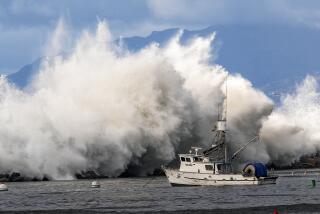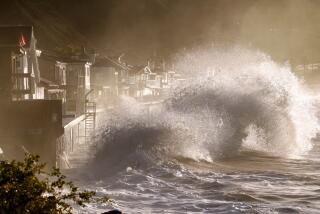Protective Services
Wade Roberts is ready for the worst of El Nino.
The director of Sherman Library and Gardens in Corona del Mar has had drains cleared and roof gutters cleaned on the 2.2-acre property. He’s performed similar duties at his Corona del Mar home to make sure water can flow away swiftly from structures and off his property.
He’s checked to see that drains are clear by running a hose at high pressure through the drains to see how fast the water flows through.
To keep drainage lines clear of tree roots, he invested in a rooter machine. A snake attached to the end of the line cuts tree roots that have invaded drains.
Rico Montenegro, assistant director of the Fullerton Arboretum, advises homeowners who are worried about an onslaught of intense rain and wind to secure hillsides or slopes with fences or vegetation.
And Vic Eggars, co-owner of V & E Tree Service in Orange, says to inspect and prune mature trees before they topple or lose branches. Heavy rains add extra weight and soggy soil weakens root systems.
“If you remove dead branches and those from overhead wires, and prune to permit winds to pass through, there should be minimal or no damage from El Nino,” Eggars says.
With these precautions, landscapes should do well despite heavy storms. “In fact, the rains can be very beneficial because they leach accumulated salts from soils,” Roberts says.
PREVENTIVE MEASURE CHECKLIST: YARD AND GARDEN
* Remove Puddles: Because water hampers oxygen from reaching plant roots, puddles should be removed from gardens. Montenegro suggests cutting a swath through and underneath the lawn then digging a narrow trench to direct the water to the lawn where it can percolate. After the excess water has drained, the grass can be laid back in place.
* Drain Standing Water: Standing water can accumulate in houses built on concrete slabs or on properties where slopes direct water to structures.
If you spot a potential problem, Montenegro recommends installing a French drain: Dig a trench 1 foot deep and 6 to 8 inches wide. Make it long enough to carry water to the property’s lowest part. Install flexible or perforated pipe in the trench. Backfill with coarse rock. Cover surface with gravel.
* Inspect Shurbbery: Like trees, woody perennials and shrubs with dense growth and heavy leaf canopies are susceptible to rain and wind. Inspect to see if any bend from the water’s weight. Protect those by staking or surrounding with wire cages.
* Create Drainage: Protect landscapes by cutting small depressions between the edges of lawns and landscapes. “These areas are usually flat. But if there’s a 2-inch space along the lawn edge, water can drain away,” Montenegro says.
* Reinforce Hillsides: Houses on or below slopes are at risk if hillsides collapse. Reinforce the area by rolling jute over bare ground and secure it with staples. For long-term protection, plant ground covers or prostrate shrubs with deep root systems. Landscape experts recommend wild lilac (Ceanothus), coyote brush (Baccharis pilularis), Mexican evening primrose (Oenothera berlandieri) and some varieties of bougainvillea. Or overseed with a mixture of native grasses. Should heavy rains arrive before you are prepared, at right are some other ways to protect your property.
Filling and Stacking Bags
Here are some important things to remember when using sandbags, which are normally made of burlap or nylon:
* Filling: Fill halfway; overfilling makes bags heavy and difficult to move and stack
* Placing: Stack with flap tied or tucked under and pointed in direction of mud/water flow
* Stacking: Tightly layer, with each layer staggered; rows should be no more than three layers unless placed in a pyramid
Directing Debris Away From House
* Layer bags away from building to divert any flow of debris moving downhill
* Bags may be stacked along street to help direct flow should curbs be unable to hold back water
Where to Get Sandbags
Both city and county fire departments, listed on the Web site, will provide empty sandbags, which can be picked up at the nearest station. Residents must fill the bags. If sand is not available, bags can be filled with dirt or rocks.
OTHER PREPARATIONS
Prepare a Supply Kit
These items should be handy in case of any disaster:
* First-aid kit
* Battery-powered radio and flashlight, with spare batteries
* Rubber boots and rain ponchos
* Three-day supply of bottled water (one gallon per person per day)
* Canned food and opener
* Extra set of car keys and a credit card, small-denomination currency or traveler’s checks
Preventive Repair
* If your roof leaks, fix it now
* Consider buying plastic sheeting in case your roof develops a leak
* Make sure windows are watertight and reinforce caulking where necessary
* Clear out gutters to ensure they can handle heavy rainfall
Paperwork
* For insurance purposes, prepare a list of--and photograph--furnishings, clothing and valuables
* But flood insurance; know name, phone number and location of agent
* Store valuable documents in safe deposit box
Make a Plan
* Know your area’s flood risk--if unsure, call your local emergency management office
* Learn safest route from home or business to high, safe ground
* Make sure children know school’s and family’s emergency plans
* Remind your family where to meet if it is unsafe to return home
Your Car
* Keep a smaller disaster supply kit in he turn of your car and at your workplace
* Make sure your vehicle is in good condition and check tires for wear level
* For More Information: Consult Orange County’s El Nino Preparedness Web site at https://www.oc.gov for a telephone directory on whom to call for more information. The Orange County Red Cross offers disaster preparedness classes. Call (714) 835-5381 ext. 100.






